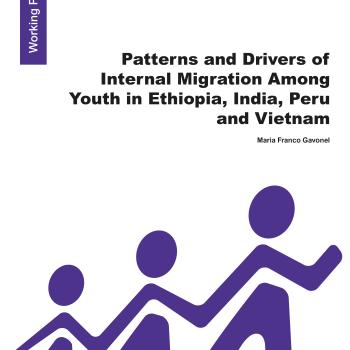Publication Information

There is general consensus in literature on migration that migrants are primarily young people. During the transition to adulthood, young people make important choices regarding education, labour force participation, and family formation. Using a unique panel dataset on youth born in 1994-95 in Ethiopia, India, Peru, and Vietnam, this working paper investigates how life-course transitions to adulthood relate to patterns and predictors of internal migration in low- and middle-income countries. It documents patterns on prevalence, frequency, timing, reasons and streams of migration, employment at destination, subjective well-being, and migration aspirations. The paper then describes the factors associated with young men and women’s decision to migrate, and the reasons for migrating.
The results suggest that there is a significant share of migrants between 15 and 19 years old across all four countries, and they are very likely to move more than once. In all countries, migrants are more likely to move after the school-age years, between ages 17 and 18. These patterns on frequency and timing of moves provide new evidence that young individuals migrate very often even before having finished school, which is key to understanding educational performance. The patterns on the reasons for moving provide evidence that young people move for a variety of reasons that go beyond the economic-related: family formation and family reunion are also important motives for migrating, especially in the studied age range. The migration streams presented show that these youth do not necessarily follow rural-urban migration as it is generalised in the literature, and they shed light on the dynamics of the less studied rural-rural migration. The results suggest that at this age, migration is a household strategy: although migrants do not necessarily contribute remittances to their previous household, they are often receiving them from their caregiver.
Choices made during the transition to adulthood shape young people’s migration patterns, and migrants are therefore a very heterogeneous group as there are systematic differences in their characteristics depending on their reasons for moving. This is important because understanding this puts us in a better position to propose more effective policies that target young migrants’ well-being in developing countries.

There is general consensus in literature on migration that migrants are primarily young people. During the transition to adulthood, young people make important choices regarding education, labour force participation, and family formation. Using a unique panel dataset on youth born in 1994-95 in Ethiopia, India, Peru, and Vietnam, this working paper investigates how life-course transitions to adulthood relate to patterns and predictors of internal migration in low- and middle-income countries. It documents patterns on prevalence, frequency, timing, reasons and streams of migration, employment at destination, subjective well-being, and migration aspirations. The paper then describes the factors associated with young men and women’s decision to migrate, and the reasons for migrating.
The results suggest that there is a significant share of migrants between 15 and 19 years old across all four countries, and they are very likely to move more than once. In all countries, migrants are more likely to move after the school-age years, between ages 17 and 18. These patterns on frequency and timing of moves provide new evidence that young individuals migrate very often even before having finished school, which is key to understanding educational performance. The patterns on the reasons for moving provide evidence that young people move for a variety of reasons that go beyond the economic-related: family formation and family reunion are also important motives for migrating, especially in the studied age range. The migration streams presented show that these youth do not necessarily follow rural-urban migration as it is generalised in the literature, and they shed light on the dynamics of the less studied rural-rural migration. The results suggest that at this age, migration is a household strategy: although migrants do not necessarily contribute remittances to their previous household, they are often receiving them from their caregiver.
Choices made during the transition to adulthood shape young people’s migration patterns, and migrants are therefore a very heterogeneous group as there are systematic differences in their characteristics depending on their reasons for moving. This is important because understanding this puts us in a better position to propose more effective policies that target young migrants’ well-being in developing countries.

